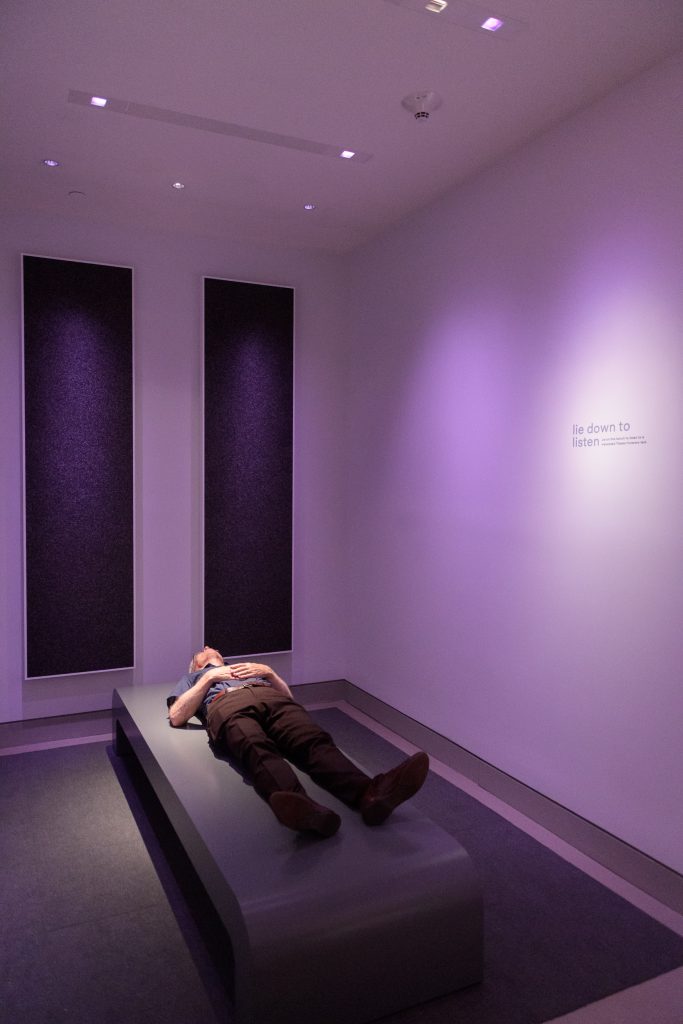Sound is transformative. A decades-old commercial jingle or a call from a childhood friend can transport us back in time, while the lap of water against a dock or the gentle hum of rain falling on the sidewalk can lull us into a deep sleep. Other sounds—clapping and drumming, singing and cheering—can rouse the body into an excited state.
From a Buddhist perspective, sound is not only transformative, but also liberating. The World Is Sound, a new exhibition at the Rubin Museum of Art in New York City, encourages visitors to develop new ways of listening that can expand their consciousness and free them from ingrained, habitual ways of relating to the world.
“The exhibition departs from a pure focus on the visual and ventures into the power of sound and the practice of listening,” said Risha Lee, the exhibition’s curator. “Sound is not limited to what we hear with our ears. It is composed of vibrations that resonate in our body and flow through a resonant world.”
The exhibition, which features historical Buddhist art displays and site-specific pieces by contemporary sound artists, is a multisensory journey beginning with the sounds of creation from a variety of perspectives. A video titled Resonant Universe, produced in collaboration with the Museum of Natural History, explores the sacred syllable om. Visitors can experience the power of communal chanting by listening to a composition of ambient oms, which were recorded by visitors to the museum’s “OM Lab” earlier this year. A series of sonic recordings by artists C. Spencer Yeh, Samita Sinha, MSHR, and students from the Columbia Sound Arts MFA program introduce listeners to imagined sounds that may have accompanied the big bang.
The sounds and listening rituals associated with Buddhist traditions are also central to the exhibition. Visitors are invited to place their hands on the walls so they can feel the vibrations of various mantras, such as the Heart Sutra [which details the foundation of liberation] and om mani padme hum [the mantra used to develop compassion]. Motion-activated technology plays choral music and sounds associated with certain ritual objects, such as a manuscript of vocal chants or statue of a deity. Visitors can also view 18th- and 19th-century instruments that are central to Buddhist devotional ceremonies, such as the long horn (dung chen) and hand drum (lak nga). In another section, visitors can recline and listen to a translated Tibetan funerary text that is intended to guide the consciousness of the deceased through the bardos [the stages after death but before rebirth].
Several pieces in the exhibition encourage more subtle methods of listening. Le corps sonore, a sound installation designed by artists Éliane Radigue, Laetitia Sonami, and Bob Bielecki, emits ambient drones that sound through the Rubin’s iconic spiral staircase. As visitors move through this space, the tones seem to fade in and out, providing a richly audible experience of impermanence—a central Buddhist teaching.
Another section of the exhibition features works by artists and political activists John Giorno and Christine Sun Kim. Giorno’s paintings, which include large typeface sayings such as “BIG EGO” and “YOU GOT TO BURN TO SHINE,” provoke questions about the sound of our thoughts and how they are influenced by mass media. Kim deconstructs socially informed ideas about sound through drawings; in her works, she creates certain sounds by drawing arrangements of classical music notations called dynamics. In her piece The Sound of Obsessing, for example, the repetitive use of the symbol p reflects the rhythmic behavior of an individual constantly revisiting a thought.
Similar to the other pieces in the exhibition, the work of these artists asks visitors to broaden their definitions of listening.
“As much as the artists question the politics of voice, their work collectively communicates an optimistic message about the potential of voice to transform our inner and outer worlds,” Lee wrote in a publication that accompanied the exhibition.
The World is Sound runs from June 16, 2017, through January 8, 2018. Articles from Spiral, the publication that accompanies The World is Sound exhibition, are available online. Tickets are $15 for adults and $10 for seniors.
Thank you for subscribing to Tricycle! As a nonprofit, we depend on readers like you to keep Buddhist teachings and practices widely available.
